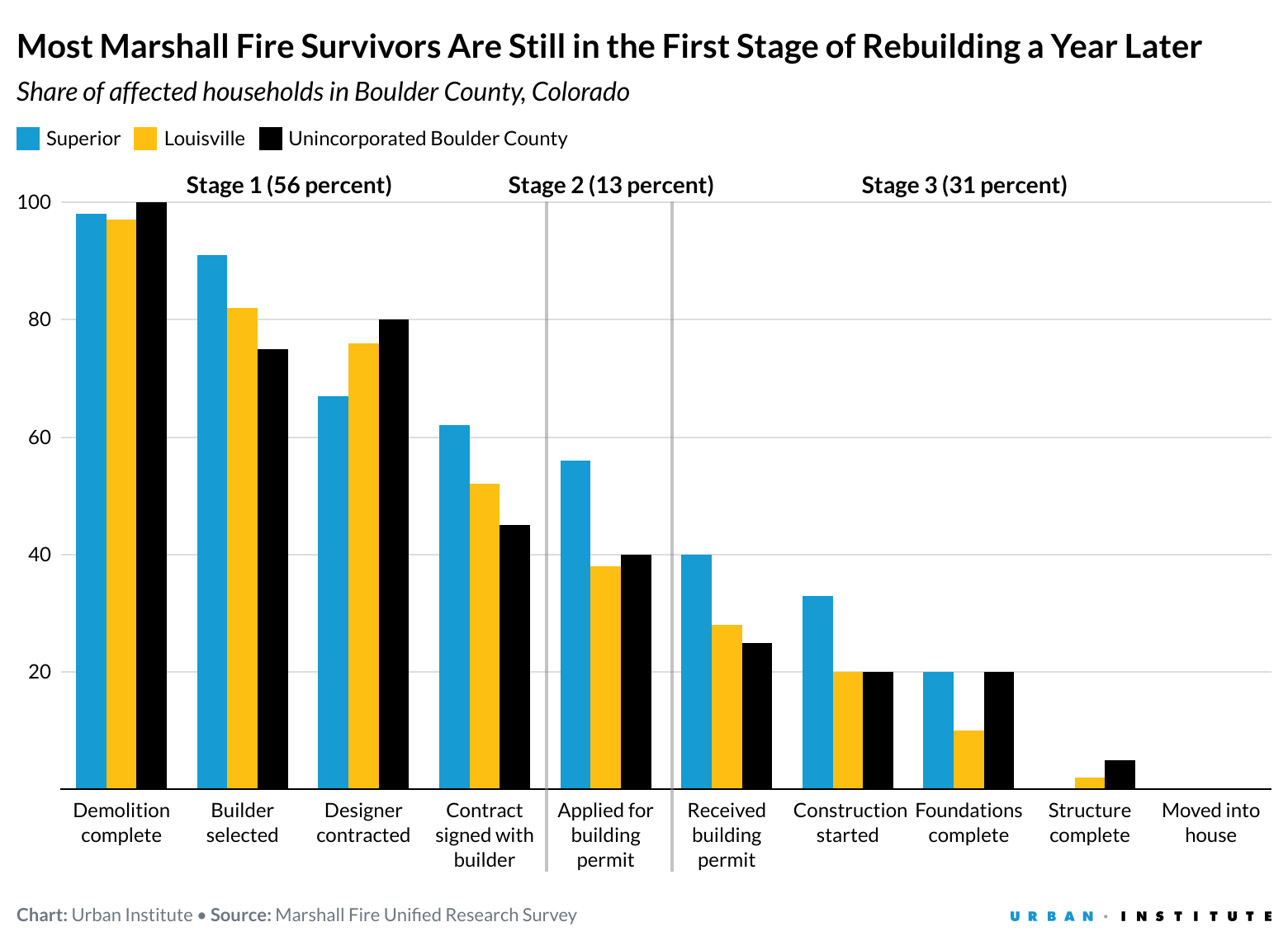
Fifteen months ago, the Marshall Fire swept through Boulder County, Colorado, killing two people and destroying 1,084 homes—making it the most destructive wildfire in state history. Since the fire, Boulder County has progressed toward recovery, with nearly all of the destroyed structures demolished and their lots cleared. As of March 24, 2023, the three local governments coping with fire recovery have issued 440 rebuilding permits to allow for construction to begin, and a handful of families have even moved back home.
These signs of recovery are encouraging and should be celebrated, but past disasters teach us that recovery is a long, uneven process. To better understand who rebuilds quicker (and why) during the recovery process, we surveyed Marshall Fire survivors in two waves—at six months and a year after the disaster. We found that in the three communities coping with fire recovery, those with higher incomes were more likely to have the resources to rebuild and are rebuilding more quickly.
Cost and time are major factors driving the decision to rebuild
One common way to measure progress in disaster recovery is counting the survivors who choose to return and rebuild their homes. During the first wave of our survey, we asked all respondents how likely they were to rebuild. A large majority of respondents in all jurisdictions said they would definitely or probably rebuild (80 percent in Superior, 79 percent in Louisville, and 72 percent in unincorporated Boulder County), and relatively few said they probably or definitely would not rebuild (8 percent in Superior, 14 percent in Louisville, and 17 percent in unincorporated Boulder County).
Unsurprisingly, cost was the most important consideration across communities for those considering rebuilding. Time also was a commonly cited consideration influencing attitudes about rebuilding, and we suspect it’s become even more important as the recovery enters its second year.
The second wave of our survey shows relatively few respondents (3 percent) who had lost their home had sold their property by January 2023. For those who still owned their property, the multiple steps needed to successfully rebuild their home proved complex. To rebuild, a Marshall Fire survivor must achieve the following:
- Stage 1, prebuilding permit: Demolish home, remove debris, select a builder, contract with a designer or architect, and sign a contract with a builder
- Stage 2, apply for building permit: Acquire city, town, or county approval of the building plans
- Stage 3, postpermit: Receive their permit and start construction, complete the foundation, complete the structure, and receive a certificate of occupancy before finally moving into their home

A year after the fire, we found that most respondents (56 percent) are still in stage 1, with only Superior having a small majority (56 percent) who have applied for or received a building permit.
Households with fewer financial resources are falling behind
When we break down these numbers by income, a clear pattern emerges: survivors with higher reported household incomes are more likely to be in the postpermit stage of rebuilding compared with those making less. For households making less than $75,000 per year, 70 percent are still in stage 1, compared with 38 percent of those making more than $200,000.
Similarly, we find that a household’s insurance coverage is correlated with rebuilding progress. In the second wave of our survey, just 4 percent of respondents expected insurance to cover all their rebuilding costs, and about 10 percent expected insurance to cover less than half. These expected coverage levels also correlated with household income, as higher-income households with insurance had higher expected payouts and lower-income households experienced greater levels of underinsurance. Nearly half of households with incomes above $150,000 expected insurance to cover at least 75 percent of their costs, while only a quarter of households with incomes less than $75,000 expected the same.
When comparing these respondents’ expected insurance coverage with their progress toward rebuilding, we find those who expected to receive 75 percent or more of the replacement cost of their home are much more likely to have received a building permit a year after the fire than those with less coverage.
Policymakers can help to ensure a more equitable recovery
Taken together, these findings highlight the long road many Marshall Fire survivors still face as they rebuild. State and local leaders have emphasized the return of residents is an important recovery measure. The path from here will likely get more difficult as households who lack the financial resources to rebuild struggle to move forward.
Underinsurance has already posed difficulties to rebuilding for many households affected by the fire. Our research suggests further policies and programs that provide rebuilding assistance for those with fewer resources should continue to be a top priority. With more than a year already elapsed, inequities in recovery efforts will become more pronounced if additional resources aren’t available.
This material is based on work supported by the National Science Foundation under Grant No. 2220589. The work was also made possible with support from the JPB Environmental Health Fellows program and the Natural Hazards Center at the University of Colorado. Any opinions, findings, and conclusions or recommendations expressed in this material are those of the author(s) and do not necessarily reflect the views of the National Science Foundation or other supporting organizations.
Let’s build a future where everyone, everywhere has the opportunity and power to thrive
Urban is more determined than ever to partner with changemakers to unlock opportunities that give people across the country a fair shot at reaching their fullest potential. Invest in Urban to power this type of work.